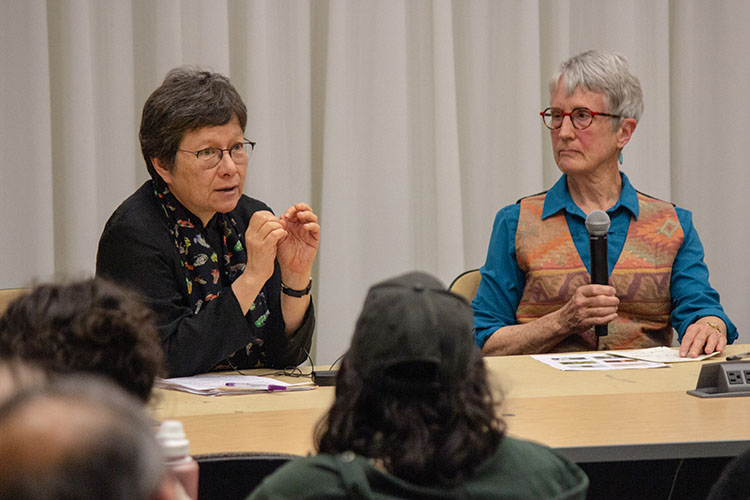
Before last week, I had never actually looked at what the word ending cene means. Originally from the Greek word kainos, meaning recent or new, the term has shifted to mean a specific period of time, distinguishing one period from another. In the context of Anna Tsing and Donna Haraway’s talk about the Plantationocene, they agree that the term means “condition,” which I understand as “the conditions under which we live.” The conversation between Tsing and Haraway at the Center for 21st Century Studies last week redefined yet again one of the facets of our living conditions. Many scholars are now familiar with the term Anthropocene, proposed by scientists and seized by academics as a way of describing what it’s like to live in the world now that human-caused environmental change and potential catastrophe is irreversible. Some of us may be familiar with the argument for the term Capitalocene, or Haraway’s own radical concept of the Cthulucene. Both Tsing and Haraway are invested in the ongoing use of the term Anthropocene, but agree that it must be extended to account for uneven social and natural processes. This extension calls for yet another name.
The Plantationocene, the new term devised by Tsing and Haraway, highlights the historical context of how the Anthropocene came to be. The term enhances, rather than replaces, the concept of the Anthropocene. It refers to the shift in conditions caused by the invention of the plantation. According to Tsing and Haraway, the plantation is an apparatus that caused the “re-doing of worlds,” or a re-ordering of environmental and economic systems on a global scale. They describe different types of damage caused by this re-doing, shedding light on the gravity of such a condition. First, the modern concept of race was created through the plantation, and the conditions of coerced labor resulted in a steady stream of commodities. The profits reaped of plantation labor made possible the industrial revolution in Europe. The alienation and discipline born of the plantation labor system have also followed us into the twenty-first century. Adaptations of plantation labor conditions have continued for centuries, from the factories of the industrial revolution, inspired directly by the plantation, to the precarity of platform labor in the present day. Our non-human and more-than-human kin have also been affected by the Plantationocene. The disciplining of plants and animals has been naturalized, and farming institutionalized. Pathogens have evaded the ecological simplification tactics of generations of engineers as new strains of fungi and diseases emerge in response to the plantation system’s attempts to control agriculture. Thus, a set of four historical conjunctures bring us into the world-ripping infrastructural changes of the Plantationocene: Invasion, Empire, Capital, and Acceleration. It is to these conditions of the Anthropocene that Tsing and Haraway are interested in drawing our attention.
“This is a dark view of our current condition. It is dark because the heritage we have received is dark.” Anna Tsing read my mind. Everything in the Anthropocene and its extension the Plantationocene seems apocalyptic. Both scholars acknowledge this negativity and implore us to move forward anyways. Haraway urges us to allow affective attachments to form between ourselves and everything we come into contact with. In a time when young people seek respite and connection in their smartphones only to become more isolated; when empathy for other people, much less other beings is at a record low, this seems like a lot to ask. However, Haraway urges us to be accountable for the connections we forge despite the challenge this poses.
To show us why this is not only possible but inevitable, Haraway gives the example of a strawberry grown near Monterrey Bay in California, where industrial farming practices mean they are bombarded with pesticides and fungicides. We, upon eating them, become accountable in the world differently than before. Part of this difference, according to Haraway, lies in the love we have for the fruit. Because “Who doesn’t love a strawberry?” she exclaimed rapturously. She argues that once we cultivate pleasure and love for the product of this system, we become affectively and cognitively part of the building and rebuilding of the possibility of living well together. To be clear, we do not live well together with the strawberries we infuse with toxic chemicals—we must reconfigure our love in such a way that includes the well-being of the strawberry we eat, the soil it grows in, the waters of Monterrey Bay, the native fungi, the microbes. All of this, Haraway says, must occur for us to survive, and possibly even survive well.
Ultimately, these scholars do not ask that we trade out one cene for another. Rather, the usage of myriad terms indicates the importance of language in our understanding and sharing of attachment. Naming has the potential to both isolate us and connect us. Citing the example of Inuit speakers who have numerous words and variations on the term “weather,” Haraway vies for linguistic openness. Through language, we can learn from each other and work together. We can cultivate the attachment sites—relationships based on mutual knowing and mutual need for ongoingness—that situate us in relation to everything else. Haraway, who said during the talk that she is “promiscuous with words,” also describes the “thick present”—a present laden with awareness, connection, and attachment. Maybe these are all different names for the same thing. But maybe by working through these taxonomies and exploring the depths of the thick present, we can make better our cene.